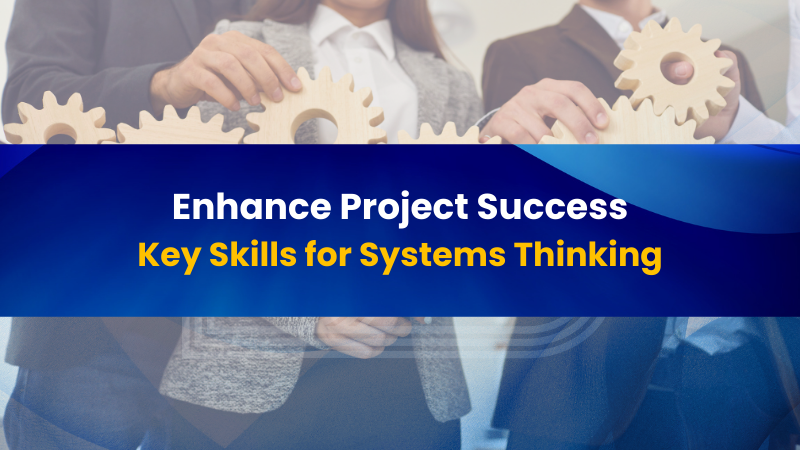
by DharamCW | Aug 28, 2024 | Leadership in Project Management, Project Management, Project-Program-Portfolio Management Knowledge
Enhance Project Success: Key Skills for Systems Thinking
As a project manager, you play a crucial role in the success of a project. A project is a system of interdependent and interacting domains of activity. Systems thinking entails a holistic view of how project parts interact with each other and external systems. Systems are constantly changing, requiring your consistent attention to internal and external conditions. Your responsiveness to system interactions allows your project teams to leverage positive outcomes.
The following skills support a systems view of the project:
– Empathy with the business areas
– Critical thinking with a big-picture focus
– Challenging assumptions and mental models
– Seeking external review and advice
– Use of integrated methods, artifacts, and practices so there is a common understanding of project work, deliverables, and outcomes
– Use of modeling and scenarios to envision how system dynamics may interact and react
– Proactive management of the integration to help achieve business outcomes

Enhance project success with key systems thinking skills—holistic project management in action.
By honing these skills, project teams can enhance collaboration, adaptability, and, ultimately, project success. Remember, these skills are not just beneficial; they are essential for your professional growth and the success of your projects.
🚀 Elevate Your Project Management Career:
– Register for my upcoming PMI Certification Success Story Webinars: https://bit.ly/3Lpjifb / https://bit.ly/4fJdX0c
– Book an obligation-free consultation session on Project management Career, training, and certifications: http://talktodharam.com
– Discover training offers and certification discounts: https://bit.ly/3jWVepD
– Stay updated with our Q&A series and certification success stories by subscribing to the vCare Project Management YouTube channel at https://bit.ly/2YF0wJl
– Follow my podcasts and interviews with Project Management Experts on YouTube at https://bit.ly/2NDY8wd
#SystemsThinking #ProjectManagement #SkillsDevelopment #PMBOK #PMBOK7 #PMP #Empathy #Innovation #Agile #Waterfall #ProjectLeadership #HolisticProjectManagement #CriticalThinking #PMPCertification #PMPExam #PMPTraining #BusinessAnalysis #ChangeManagement #ProjectDelivery #ProjectSuccess #ProjectTeams #SystemsDynamics #BusinessOutcomes #HybridProjectManagement #AskDharam #DharamSingh #VCareProjectManagement
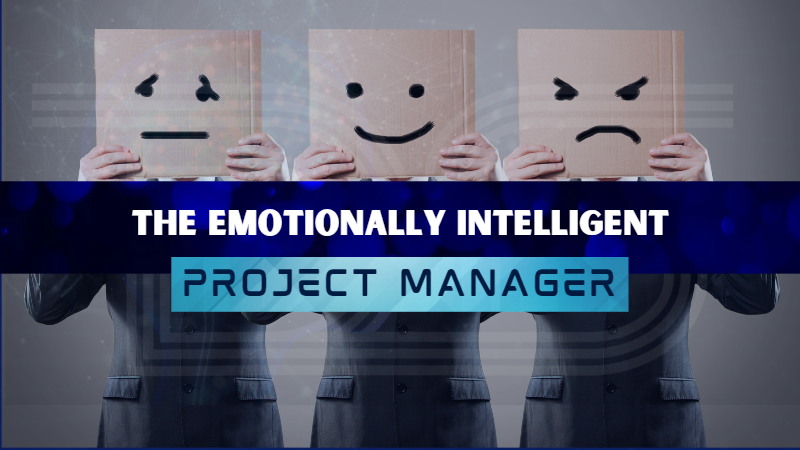
by Dharam CW2 | May 19, 2023 | General
Emotional intelligence in the workplace is becoming increasingly important for leaders and project managers as remote work became more prevalent due to the pandemic. Success in project management and managing cross-functional remote teams is only possible with emotional intelligence.

Capterra Survey
According to a Capterra survey, emotionally intelligent project managers (PMs) are approximately 11% more successful at managing processes, engaging stakeholders, avoiding scope creep, and efficiently using resources than PMs who lack this skill.
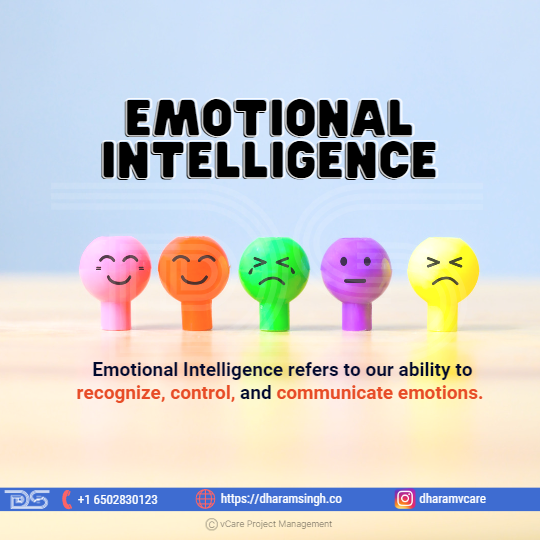
Emotional Intelligence
What is Emotional Intelligence?
Emotional intelligence refers to our ability to recognize, control, and communicate emotions. People with high emotional intelligence understand how they feel, what their feelings imply, and how their feelings affect others. In interpersonal situations, it is also the ability to empathize with others. Emotional intelligence is about creating a positive work environment, which is critical to the success of any project.

As Per LiquidPlanner Study
According to a LiquidPlanner study, most project managers commit approximately 10% of their time to people-related activities. Top project managers dedicate 70% of their time to these activities. As a result, we can conclude that emotional intelligence is crucial for project success.

Importance of Emotional Intelligence for Project Managers
Importance of Emotional Intelligence for Project Managers
- Emotional intelligence is essential for leading cohesive, high-performing teams.
- According to researchers and behavioral scientists, Emotional intelligence impacts how leaders communicate with their teams and how team members interact.
- Emotionally intelligent leaders and managers understand how to control their emotions and behavior at work, which includes providing safe environments for exchanging ideas and feedback, productive teamwork and performance, good morale, employee engagement, and job satisfaction. They manage workplace stress and conflict with care and educate their team members to do the same.
Characteristics of Emotional Intelligence
What can project managers do to help themselves develop and become more aware? First, let’s examine five abilities for raising emotional intelligence:
- Self-Awareness – The ability to sense, identify, and comprehend emotions is self-awareness. Unfortunately, many of us were taught to ignore our emotions in the past. However, it is critical to be aware of your feelings to make appropriate decisions and act accordingly. Those with high self-awareness are self-assured, authentic, open to feedback, and capable of maintaining perspective throughout all project phases.

Characteristics of Emotional Intelligence
- Self-Management – Self-management is the ability to reason well while understanding feelings. Many frequently react based on their frame of reference rather than selecting a response based on their current unique circumstances. Self-managers are deliberate in decision-making, taking the initiative, framing events appropriately, maintaining perspective, and responding quickly. They understand their feelings and why they have them and effectively manage their responses.
- Self-Motivation – Self-motivation is the ability to channel the power of your emotions toward a specific goal. When project teams have a purpose, these ‘P’s follow peace, passion, power, perspective, and potential leverage. Self-motivators who are influential are optimistic and have a positive attitude. They can delay gratification and assert themselves.
- Interpersonal Management – The capability to identify and respond properly to the emotions of others is referred to as interpersonal management. If you can connect with people and acknowledge their humanity, they will answer openly, leading to common trust.
- Leadership – An emotionally intelligent project manager inspires guides, challenges, and supports the team. Leadership is defined as the ability to create and communicate vision and passion for assisting individuals and organizations in reaching their full potential.
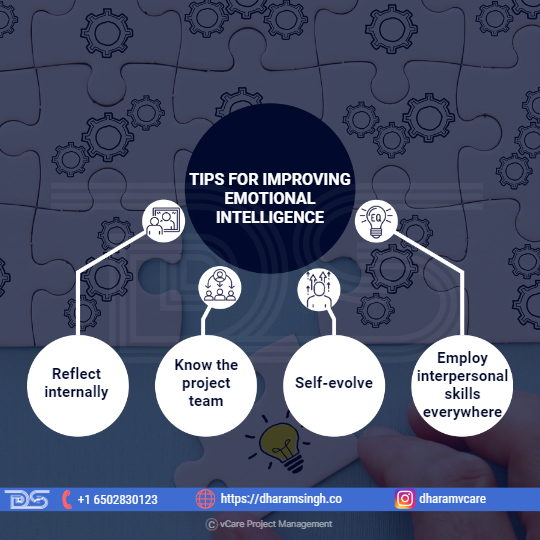
Tips for improving Emotional Intelligence
Tips for improving Emotional Intelligence
- Reflect internally – To become more emotionally aware, one must first understand their emotions and then regulate them in stressful situations. Next, they have to figure out what motivates them. Finally, authenticity is necessary to develop emotional intelligence by leading a successful project team and establishing meaningful relationships with stakeholders.
- Know the project team – Project managers are usually aware of the people they must contact when working on a project. However, understanding the project team, from team dynamics to personalities to dealing with conflict and stress, is just as important. To improve emotional intelligence, one must first get to know their team, communicate with them, and understand their emotions. It will also help the success of their project. This job becomes even more important for teams that operate in multiple locations and are diverse.
- Self-evolve – Along with other important leadership talents, project managers should work to improve their emotional intelligence regularly. Conditions surrounding a project frequently change; its scope may shift, the number of stakeholders may increase, and projects may eventually end.Every project is distinct, and no project manager can complete a project independently. Therefore, it is advantageous for project managers to consider what they learn during and after a project. For example, consider how a project team operated, what they witnessed during critical times with stakeholders, and their team’s performance.
- Employ interpersonal skills everywhere – Emotional intelligence can be helpful in almost any project management situation. For example, people may feel compelled to sign off on a strategy to minimize delays while managing scope changes or project risk. Following the resolution of such issues, an emotionally intelligent project manager would pursue people because they notice that this could lead to more severe problems in the future.

ABCD Trust model
ABCD Trust model
Better relationships will result in better outcomes. That is why developing trusted connections is critical to the success of your organization. When individuals trust one another, they may work efficiently together.
It is well known that low trust harms morale, productivity, and turnover. To prevent these traps, Ken Blanchard created the ABCD Trust Model to help executives understand the activities that affect creating trustworthy relationships.
Blanchard suggests four critical aspects for leaders to develop trust with people: Able, Believable, Connected, and Dependable.
- Able – The term able refers to the ability to demonstrate competence. Leaders demonstrate competence by possessing the necessary skills, education, credentials, and experience. They also exhibit their capacity to lead by accomplishing achievements. Able leaders can encourage people and collaborate with them to achieve goals.
- Believable – Being credible entails operating with honesty. Believable leaders adhere to a set of core beliefs. They know what they stand for and will not compromise their principles under pressure. Being credible also means maintaining promises and not lying or stretching the truth.
- Connected – Connected shows concern and care for others. This aspect fosters trust and contributes to a more engaged workplace atmosphere. Being linked entails attending to people’s needs and promoting their well-being. Leaders also build relationships by giving information not only about the organization but also about themselves. Employees are significantly more likely to provide their best effort when they feel linked to leaders.
- Dependable – Dependable means showing consistency and following through. It entails holding oneself and others accountable for commitments. A trustworthy leader will accept responsibility for their acts and help their followers face adversity.
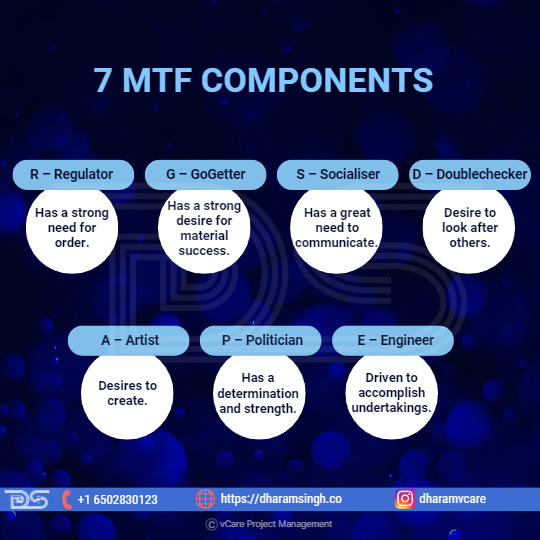
7MTF Components
7MTF Components
The 7MTF model is composed of seven components. We all have all 7 in our personalities; as adults, 2 to 4 will be strong, some will be weak, and others will be ordinary. This mix of elements is one of the most significant variables in deciding our temperament – our emotional predisposition.
- The R – Regulator (formerly known as the Normal) – A person with a ‘strong R’ has a strong need for Order. They will be mature, responsible, calm, and emotionless. You may hear the words ‘should,’ ‘ought,’ and ‘logical’ in their language. They have high expectations of themselves and others, including those with whom they live and work.
- The G – GoGetter (formerly known as the Hustler) – A person with a ‘strong G’ has a strong desire for material success. This individual entails enjoying money and the things it can purchase. The G is quick, opportunistic, intelligent, enterprising, and charming. They are short-term in nature, expecting results immediately or very soon. Promising a G a large monetary reward next year is unlikely to pique their attention.
- The S – Socialiser (formerly known as the Mover) – The ‘strong S’ personality has a great need to communicate. This aspect implies talking about people, fun, events, what you did over the weekend, or anything related to life. Hence, their straightforward, friendly, and frequent grin immediately.
- The D – Doublechecker – The ‘strong D’ is characterized by a desire to look after others and ensure everyone is safe. When you encounter a strong D, expect someone obedient, loyal, and concerned with doing the right thing. One of their greatest assets is their ability to anticipate difficulties and hazards.
- The A – Artist – A person with a ‘strong A’ desires to create. “I want to be different,” is what they would say. These hardworking individuals are conscientious and do not wish to offend anyone. Seek for anything unusual about their attire, such as innovative earrings, cufflinks, a six-button jacket, or an all-black ensemble!
- The P – Politician – A solid handshake and direct eye contact indicate that the ‘strong P’ is determined to win. This person has a determination and strength that others may find challenging. The spoken word is the strong P’s stock in trade – look for status markers like the huge Mercedes in metallic blue.
- The E – Engineer – A person with a ‘strong E’ personality is driven to accomplish undertakings. The strong E has traits such as process, detail, and procedure. This individual can form a strategy and make it happen as soon as they see anything. The E is concerned with completion. So, unless you can assist, you should avoid getting in the way!
Wisdom – strive for mental stability and individual resilience – 10 Competencies
Wikipedia defines wisdom as the “ability to contemplate and act using knowledge, experience, understanding, common sense, and insight.” Psychologists have created a list of ten competencies that are typical therapies in their field and are referred to as wisdom. Self-awareness, self-control, and empathy are the three components of emotional intelligence (EI). Although the fourth component of EI is not formally mentioned among the ten competencies, social influence or influencing others may be considered a result of being highly effective in the other areas.
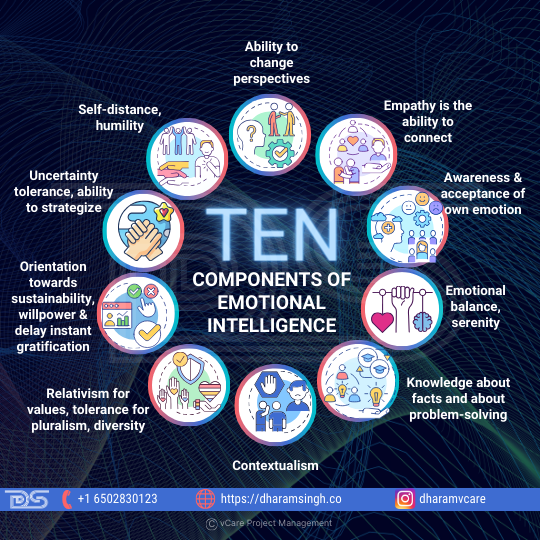
Ten Components of Emotional Intelligence
- Ability to change perspectives – In a bipolar environment, it is possible to remain trapped in one thought and dislike the other viewpoint with strong emotions, which may lead to violence. The ability to look for and identify more points of view implies a shift in viewpoint. Some of the therapies used to treat mental illnesses can help with this. Examples include role-playing, acting, visiting people in various countries, learning about diverse cultures, and brainstorming.
- Empathy is the ability to connect – Understanding people’s intentions, current state of mind, emotions, and mindsets is necessary for being heard, establishing trust, and influencing others. In addition, active listening techniques may help you focus outside yourself and view others as humans who vary from ourselves.
- Awareness & acceptance of own emotions (self-awareness) – Self-awareness leads to increased self-confidence and sincerity. It refers to mindfulness, or being aware of one’s feelings, and is required for self-control and emotional balance.
- Emotional balance, serenity (self-control) – Patience, serenity, and avoiding knee-jerk reactions make you more popular and respected and contribute to mental tranquility. Having a mentor can help you develop and fine-tune this skill.
- Knowledge about facts (know what, assimilation) and about problem-solving (know-how, accommodation) – Wisdom includes knowledge; therefore, it has two components.
- On the one hand, we have factual knowledge about a topic; on the other, we may be specialists in a (typically technical) area. This heuristic knowledge and assimilation are how we apply established systems to circumstances.
- On the other hand, when we encounter new situations or topics, we use accommodation to apply our problem-solving skills. We employ our epistemic intelligence and heuristics to do this.
- Contextualism (consider the situation, timeline, and social relevance) – Even though we have theories and may find similarities in new scenarios, each situation is unique and depends on the circumstances, the context in which the problem develops, and the societal importance. This capacity is achieved via awareness and avoiding picking a solution that works in another context without first examining the present dependencies of the situation.
- Relativism for values, tolerance for pluralism, diversity (which is hard if you are part of the same belief systems for most of your life, like nations and churches) – There are many truths (this is known as non-monism), and yours is only one of them. Others have the right to their realities, which are based on the cultures in which they live, their beliefs and experiences, and the facts to which they have access. Value relativism allows one to accept and appreciate the values of others.
- Orientation towards sustainability, willpower, and delay instant gratification (perspective of linear and circular time flow) – We can pursue long-term goals and make decisions with both short and long-term consequences in mind.
- Uncertainty tolerance, ability to strategize (imaging solutions for scenarios) – Accept that life is unpredictable and swim through it like a river, adapting to currents and waves as they come.
- Self-distance, humility – Do not believe you are the center of the universe, which will remain when you die. Avoid being a taker rather than a giver by avoiding jealousy, bragging, pride, and greed.
Final Thoughts
For today’s project managers, emotional intelligence is a critical concept. Many companies are looking for project managers with strong technical and soft skills. Emotional intelligence is crucial in project management because it enables project managers to improve communication and collaboration in the workplace. It is essential to mention that emotional intelligence can be imparted and nurtured. This aspect implies that as a project manager, one can better oneself by controlling feelings and emotions and developing positive behaviors to influence others at work. One will make better decisions about other people’s emotions, strengths, and weaknesses once they have recognized their thoughts.
Feel free to check out my discussion on this topic with Thomas Walenta in YouTube
For any questions related to your Project Management career, training, and certifications, you can book an obligation free 15 minutes session with me by visiting http://talktodharam.com/
You can subscribe to the vCare Project Management YouTube Channel to catch future videos of our Q&A series and certification success stories: https://bit.ly/2YF0wJl
You can subscribe to and follow my podcasts and interviews with Project Management Experts on YouTube at https://bit.ly/2NDY8wd

by DharamCW | Jun 20, 2021 | Personal
Today is the day I was born again with the freshness of wellbeing and feeling the goodness of staying alive. Yet another birthday reminder set in my gadget resonates in the morning hours flashing in screen “Happy Birthday Dharam, it’s your 51st year on this beautiful earth”. Freezing my alarm bell, I sit in solitude silence with many thoughts running in my mind, “What Next, What Next, and What Next.”
After performing my daily yoga routine, I start to feel relaxed and think about sharing my experience of how I survived and thrived during this pandemic through what I call a “What Next Approach” to achieve success. As we see the historical strategies, I came across a P-R-S (Problem, Reaction, & Solution) strategy that perfectly matched our current scenario. Here the problem is the COVID-19 crisis, and we need a reaction, i.e., a call to action (What next action will we take)—finally, moving forward is the solution of surviving throughout the crisis till it ends. Surviving and thriving are synonymous with each other. Surviving is like riding a car or a bike, and thriving is the fuel. If the engine stops due to lack of fuel, that’s where the problem begins.
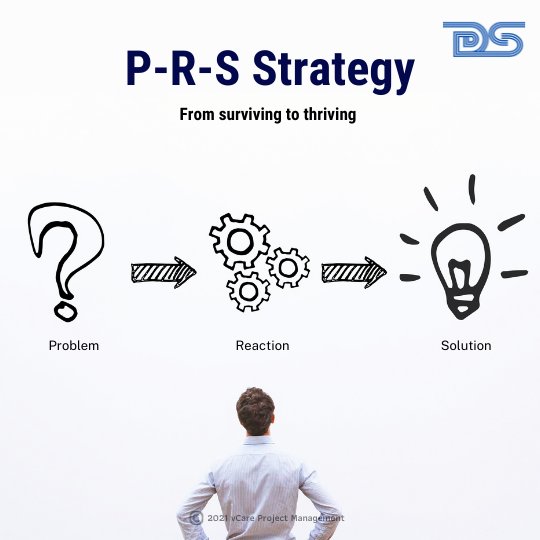
P-R-S strategy
The “What Next?” Approach
Oprah Winfrey Quotes, “Don’t worry about being successful but work toward being significant, and the success will naturally follow.”
“What Next” is a focused and futuristic approach by asking certain simplified questions to yourself and finding the best solutions to your problems during uncertainty. The list of questions given below varies individually, and you can frame “What Next Questions” depending upon your scenario. It is a self-consciousness assessment, where you will be the learner and solution provider for your wellbeing. It enables us to derail faulty thinking where we make decisions that our future selves so often later regret. I am trying to share a common template that could be useful for all.
Q1. What next to make my life better than it was before?
Q2. What next steps should I take to make progress in my professional career?
Q3. What next specific outcome you’re seeking?
Q4. What next critical behavioral change you want to do with?
Q5. What next set of trade-offs am I going to make both on the personal and professional front?
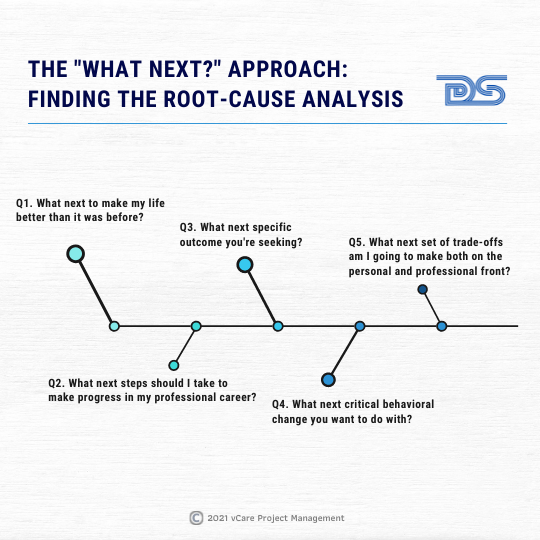
The “What Next?” Approach: Finding the Root-Cause Analysis
Current Self vs. Future Self
Einstein quotes, “Imagination is more important than knowledge.”
Imagination design your future self. Your current self creates a fixed mindset, content with whatever status you are in and stopping the roadmap for achievement. Future self generates a growth mindset and pushes us to move forward towards our goal. An uncertain future breaks you apart emotionally and behaviourally, which impacts your mindset. It ultimately leads you to cognitive dissonance, which refers to a situation used to create mental discomfort that results from holding two conflicting beliefs, values, or attitudes. We all need to break these silos within ourselves.
Empathy not Sympathy

Empathy not Sympathy
My caring for self is caring for other people. That’s what we need to establish in ourselves. Sympathy as a common feeling does not give us positive outcomes, but empathy bridges the negativity gap. Renowned psychologists Daniel Goleman and Paul Ekman have identified three components of empathy: Cognitive, Emotional, and Compassionate. So put it together, we can be mentally strong, emotionally stable, and compassionate towards the family and people we work with. Empathy helps us to overcome anxiety, embarrassment, regret, sadness, shame, and stress.
Forward-thinking leaders
Leaders are the pillar of strength to the foundation of an organization. The old school of leadership thoughts is diminishing and has created a “Leadership Vacuum.” This vacuum can be fulfilled only by forward-thinking leaders who think beyond growth by understanding the good and bad corporate world that is in place. These leaders are empathetic and have a transparent working model put in place. They connect, collaborate, and create a cohesive ecosystem for the employees to achieve their vision and goals. The whole world is filled with uncertainty, and there is no certainty that the desired objective can happen or not. Forward-thinking reshapes the decision-making process of uncertain events within the stipulated time, avoiding greater loss to the organization in the future.
Digital Adoption
As we have moved from industrial evolution to digital evolution, it is a fast-paced movement that professionals need to sync with adaptability. Until March 2020, being an individual traveling worldwide for my training programs, COVID-19 had checkmated my plan of action. It directly impacted my business, which forced me to rethink my business model. The change to digital transformation was imminent. We need to change our mindset to move on to adopt digitalization. My shift to online training programs paid dividends. I stress individuals be from the working class or in business, choosing the right tools and team are critical in achieving success despite testing times.
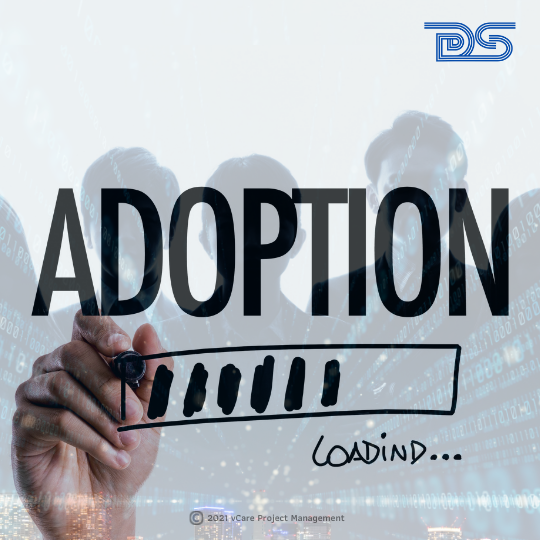
Adoption
Being Physically Active during this Pandemic
Research shows at least 150 mins of physical activity per day is required for a person to stay healthy and live longer. Most people will be spending time with exercise by going to the gym, swimming, running, be in some form of sports activities, etc. unfortunately, COVID-19 has shut down all the avenues due to social distancing. Physical activity depends on the intensity you do, and it is measured based upon it. The intensity ranges from moderate intensity to vigorous intensity, along with muscle and bone strengthening.
Division of Nutrition, Physical Activity, and Obesity, National Center for Chronic Disease Prevention and Health Promotion (CDC-DNPAO), details the Physical Activity for Particular Age Types, which I have shared here for your reference.

Types of Physical Activity
Another interesting measurement is the MET (Metabolic Equivalent of Task) which offers insight into how an individual’s variation in age, height, and body mass may influence the intensity of physical activity.
With the help of these, I am able to ascertain where I stand and plan to be more active and more productive by doing my regular physical activity routine. I got the opportunity to practice Yoga at a young age which led me to be super fit. With mudras, pranayama, and Yoga asanas, I overcame the physical disability (clubfoot) that I was born with. Gradually Yoga has made my mind, body, soul, and my entire lifestyle strong and disciplined. Yoga has created a positive synergy with extraordinary benefits both on the personal and professional front with stress-free life.
Later on, it motivated me to become a Yoga teacher to my community back in Sydney, Australia, through YiPEE (Yoga in Park for Extreme Energy) Yoga from 2011. With YiPEE Yoga, I was able to conduct free yoga sessions during the weekends to the community. In the USA, I plan to organize free community Yoga sessions once all the pandemic-related restrictions are over and people are back to normalcy. But, for now, I continue to practice Yoga indoors and record these sessions that are later shared on my Youtube Channel.
One such session that I plan to do is scheduled the day next to my birthday and during this International Yoga Day, 21st June 2021. The session is intended to communicate the true value of Yoga and realize how individuals can add quality to their mind as Yoga is all about enriching the mind and empowering the body. Yoga is the journey of the self, to the self, through the self.
Join Link: https://bit.ly/3xw4O4u
Date: Monday, 21st June 2021 [Southeast Asia & Oceania],
Sunday, 20th June 2021 [Americas]
Time: 6:00 PM – 7:00 PM (PDT) / 7:00 PM – 8:00 PM (MDT) / 8:00 PM – 9:00 PM (CDT) / 9:00 PM – 10:00 PM (EDT) / 6:30 AM – 7:30 AM (IST) / 9:00 AM – 10:00 AM (SGT/MYT) / 11:00 AM – 12:00 AM (AEST)
You can subscribe to my YouTube Channel to watch all my podcasts and interview sessions with leading project management experts, along with my yoga session videos at https://bit.ly/2NDY8wd
“The Why” and “The How” of my life

Why and How
Tracing back from a humble beginning and reaching the peak of the career path is not an easy achievement. The upward curve of my life is decided by calculated risk, a strong decision-making process, and nurturing from rightful mentors who fined tuned my path towards success. As we live in a pandemic world, and most professionals are into a midlife crisis, it is time to overcome the delusion it creates that pushes us into a panic mode. Midlife crisis is a crisis of identity at the age of 35-40 explored and researched by eminent Swiss psychiatrist Carl Jung and German-American psychologist Erik Erikson, who coined the word “Identity crisis.” On the worrying side, this delusion leads to depression and affects the biological clock of the individual.
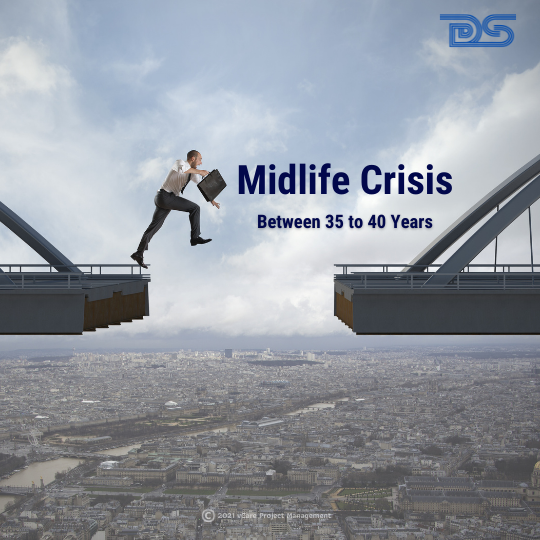
Midlife Crisis
The solution that I adopted is clearing structuring, “The Why” and “The How” of my life. “The Why” streamlined by behavior and attitude, whereas “The How” clearly defines the stages and transition in midlife crisis.
Devising self-structured questions which purely depends on your circumstances and the yardstick you’re in. Here I am sharing one question on each subline;
- Why should I live with a standardized life course?
- How can I live with an extraordinary life course?
Simple but thought-provoking questions that every man and woman would have come across. The anxiety of aging, dissatisfaction with not achieving things, and social instability created by the surroundings take a toll on us personally and professionally. I urged myself not to quit and create an obsessive focus to live an extraordinary life with extraordinary aspirations. That obsessive focus should be on what you can control and not on things you can’t control. The critical aspect is to strike a balance between family and network. I created a cluster pool of networks during my migration to Australia, which stabilized my way of living.
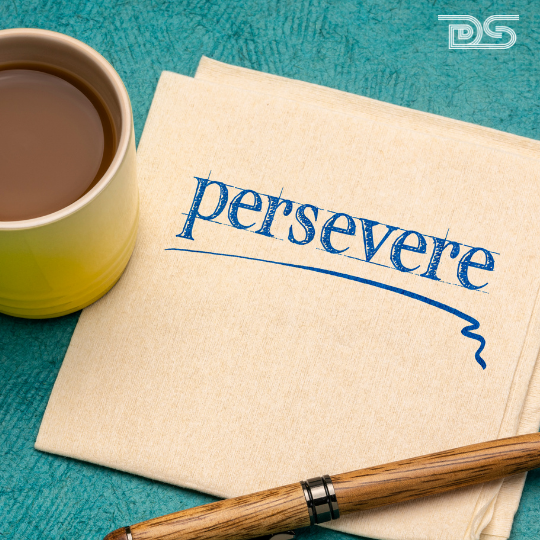
Persevere
Perseverance is one of the greatest skills you can develop during this crisis. First, you have to decide to put yourself in the category you strive for, either a standardized life course or an extraordinary life course. I chased for the latter by getting out of my comfort zone as I clearly understood that success is not a comfortable procedure. I envisioned myself getting out of this crisis through better companionship with my family and kids. They are the ones who complement “The Why” and “The How of my Life.”
Organizations ignore the middle-level managers who are profoundly between the ages of 30-35 in the organizational structure. It is the right time to spearhead those people to overcome the delusion created by the midlife crisis by proper people management and engaging them with psychological counseling. Organizations need to revisit their handling of human resources by taking steps to create work-life integration rather than work-life balance. We can’t regret losing talented professionals in that time zone. “People Value” should outweigh “Profit Value.” Let’s create a “Happiness Greenhouse” and overcome this together.
At vCare Project Management, I train individuals to be resilient project-program-portfolio management professionals and achieve success in the time-intense examinations required to obtain the most elusive advanced PMI certifications, viz. the PgMP® and PfMP®. Through my systemic approach, I unleash their full potential, enabling them to turn their aspirations into reality. As on 7th June 2021, Out of 3660 PgMP®s across the globe, 330 are my students spread across 46 countries. As on 6th June 2021, out of 1106 PfMP®s across the globe, 65 are my students who have empowered me with a 100% success rate.
If I can do it, sure can you.
Inspire yourself, and Inspire your surroundings.
Let the change begin from today!!!
Working Together For Success!!!
























Recent Comments